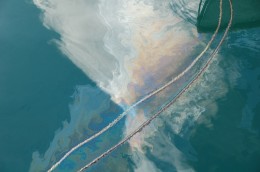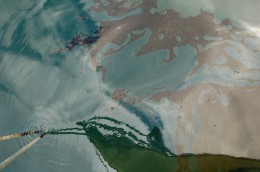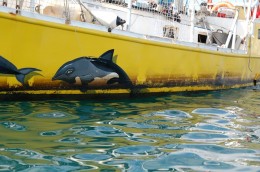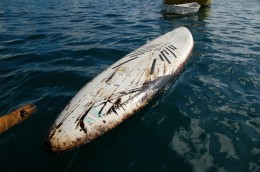Gran Canaria
Cruising notes given in good faith, but not to be taken as gospel.These notes cover the following anchorages – click the name to jump to the relevant section.
- Las Palmas de Gran Canaria
- Máspalomas et alia
- Arguineguín
- Cement Factory Bay (Bahía de Santa Agueda)
- Puerto Mogán
Las Palmas de Gran Canaria
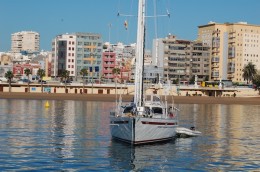
Las Palmas is the capital of Gran Canaria, of the Eastern islands, and of the whole archipelago.
By reputation, there is more crime here than in any other Spanish city, but we saw little evidence to support this accusation. True, there was recently a spate of thefts in the marina, but security here now seems to have been improved. We have also heard of petty thefts from yachts anchored near to the shore – sunglasses and snorkels have been taken from on deck by young men swimming out from the beach – but so far as we know the only boat which was actually broken into during our visit was one which had been left unattended for a period of months.
Las Palmas is also reputed to be the biggest port in “Western Africa”, and this one can believe. It is an interesting place to pass a fortnight, because there is always something going on. Cruise ships, square riggers, oil tankers, foreign warships, an endless stream of container ships… they all flow in and out of the port; we’ve even seen ship-carrying ships and oil rigs in here. Set against this background of commercial activity are yachts of all shapes and sizes, and huge fleets of Lasers, windsurfers and Optimists which pour forth from the Real Club Nautico and flutter past like confetti on the wind. Whereas in Tenerife one risks a fine for sailing into the principal port, here it actually seems to be encouraged.
Of course this doesn’t mean that the wind-driven things have right of way. A ship entering port is moving in a very restricted manner and will not give way to a sailing yacht. However, the port controllers are happy to let common sense reign; so far as they are concerned it is up to you to make sure that you don’t get run down.
Beware the ferries; in particular, beware the Armas line. The captains of the ocean-going ships appear to find the laissez faire attitude in Las Palmas a little bit nerve-wracking and they will occasionally hoot at yachts and sailing dinghies, but the Armas ferry drivers have a very gung-ho attitude. Twice now we have had to tack or gybe for Armas ferries which neglected to alter course and which would certainly have run us down if we hadn’t taken avoiding action. (On one occasion we were actually on the far side of the La Isleta peninsula, several miles from the port entrance. On the other we were about a mile off the entrance.) So, if you see a ferry bearing down on you from astern, stand off; or – if you are already close to the entrance – make a quick pirouette while he storms past.
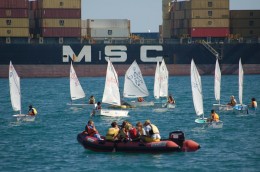
There are three marinas in Las Palmas, but the only one open to visiting yachts is the municipal one and the first that the visitor will notice. (The small Vela Latina marina is actually further south / nearer to the entrance, but it is easily overlooked.) The entrance is lit in such a way as to make it clear to the big boys that this is not the place for them. In other words, the starboard side of the entrance carries a red light flashing two plus one (Fl.2+1). This might be confusing to folks who imagine that every starboard-hand mark should be green… but it is the proper indication of a secondary channel.
The anchorage lies between the public marina and the marina of the Real Club Nautico. Even in the middle of the night it is easy to locate. Just be sure that you don’t run into the low, scarcely lit can which marks its outer limit.
Anchorage or Scrapyard?
The holding in Las Palmas is pretty good – unless you are careless enough to drop your hook on the rock which lies to seaward of the ones on the beach…
Boats do sometimes drag when the wind goes into the south and blows straight into the harbour, but they’re usually the ones belonging to people who have just left Europe and who have yet to learn how to anchor safely. As a general rule, here in Las Palmas people have more trouble getting their anchor back up than in getting it to set. This is because the bottom is very foul.
During the past winter we have watched people haul and strain, heaving up anchors which have hooked such things as a huge fish trap, a car tyre, or a mess of ropes. Last year a friend of ours brought up a sunken rubber dinghy on his Bruce!
Caesar has earned quite a bit of pocket money diving in the anchorage to clear fouled gear. Besides being the depository for all manner of unwanted junk this corner of the harbour seems once to have been scheduled for development of some kind. Lying in the deep mud amongst the clutter are several massive concrete blocks, and if you wrap your chain around one of these it will certainly affect the way your boat lies in relation to the rest of the fleet. Close to the wall of the Real Club Nautico’s private marina there are also boulders lying on the bottom. These were presumably supposed to have been incorporated into the retaining wall of that marina.
Best of all (but only from the “can you believe it?” standpoint) there are two unmarked wrecks in the anchorage!
One of the wrecks lies about 50 yards/metres from the wall of the public marina. We’ve never come across it ourselves, but we’ve heard about it from other people.
The second wreck is perhaps 30 metres to the south of the centre of the anchorage. An Italian friend, Ugo, fell foul of it and gave us the following co-ordinates: 28 degrees 07.542 minutes North; 15 degrees 25.548 minutes West.
Caesar, who swam around the wreck in the course of liberating Ugo’s anchor, reckons that the vessel is about 50 ft / 15m long and at least 15ft / 4m wide. The visibility in the harbour was so bad on this particular day that he could not see his hand in front of his face, but he thinks that it is probably a dumb barge.
When we mentioned this wreck to the marina authorities they denied its existence. What you don’t know about you don’t have to clear up.
By the way – if you are so unlucky as to haul up a fish trap or a rope or anything else of that sort, with your anchor, please don’t drop it back into the mirey depths for the next poor bastard to enjoy. If you find yourself custodian of someone else’s rubbish please do the decent thing and tow it ashore. If you can’t lift it out of the water, lash it to the marina’s rocky wall. If you can, please haul it up the rocks and dump it by the marina dustbins.
Please don’t buoy your anchor
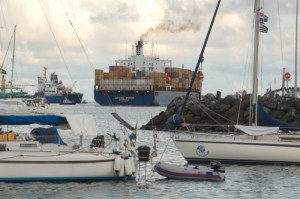
If the aforegoing information tempts you to want to buoy your anchor, please think again.
This is a crowded little corner. If you put a buoy on your anchor then you make it much harder for the next arrival to find a place to drop his hook. If he drops it well ahead of you then he will probably fall back over your buoy; and even if he doesn’t fall directly back, he – or one of your other neighbours – might easily swing and end up over your buoy.
To be anchored over a buoy is not safe because there is always the possibility that one might need to get out of the anchorage in a hurry. Perhaps your own boat will drag, or perhaps someone else will drag down onto you. But if there is a buoy under the boat then one cannot start the engine; starting the engine could easily cause the propellor to become fouled by the tripping line attached to the anchor buoy.
Thus, when he find himself in such a situation the owner of the windward boat has no choice but to remove the anchor buoy immediately; before it endangers the safety of his vessel. If he is a decent sort of fellow then he might come and discuss things with you first… but if he only speaks French / German / Polish, or if he doubts whether you will see sense, then he might just quietly untie the line one evening and let the buoy drift away.
And I say that he would be in the right.
Not only is buoying the anchor a very selfish act in a crowded anchorage, it is also self-defeating. If you don’t believe me, read this story.
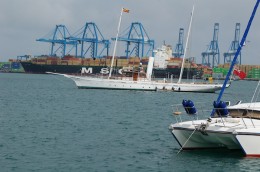
The anchorage is no longer free. We were required to pay 5.50 € per night for our 50 footer. We thought ourselves hard done by until we found that the owner of the beautiful 80ft Hereschoff moored nearby had to cough up 45 € a day! No wonder he only stayed for one night!
In return for your fee you get the right to use the showers (if you pay a deposit for the key) and the right to bring in your jerries, or the boat itself, and fill up with water.
Generally speaking there are fewer than a dozen yachts anchored here, but throughout October, November and December the place is very busy, and during the week before the ARC race it is thronged. On these occasions the authorities turn a blind eye to vessels which have been obliged to anchor outside the yellow buoy, and we have never seen anyone turned away.
The town is nothing to write home about, but it has pretty much everything that a yachtsman could need in the way of supermarkets, haberdashery shops, car hire companies, ironmongers / hardware stores, and engineering shops.
Any spares that you cannot find will be imported promptly – but be warned that anything that you have sent with a carrier will have to go through customs, and you will also to have to pay a 20 € “handling charge” for each parcel.
Don’t bother asking suppliers to ship your goods to a Yacht in Transit. It cuts no ice here; you can argue until you are blue in the face, but you won’t get hold of your goods until you have paid the import duty.
If you need any parts made, we recommend Tekkocan, in El Sebadal (the main industrial area, in La Isleta). This machine shop produced various parts for our new transmission system. If you telephone the boss, Carlos, he will happily collect and deliver parts from and to the marina (670 877 607).
Two of the best things about Las Palmas are the Chinese supermarkets, and the vegetable and fish market. These are both located just inland from the Real Club Nautico.
The worst things about the place are the stink of diesel, the constant jingle of the ambulances passing on the adjacent road, the grey skies, the want of a decent landing place, and the oil.
The hoi-polloi in the anchorage are allowed to bring their dinghies into the marina, but unless you are heading for the southern edge of the town you won’t want to do this. The vegetable market, the closest supermarkets, and the industrial quarter (with its machining shops and wood merchants, etc) all lie to the north.
Some folks leave their dinghies on the beach. Others tie them to the wall. Neither solution is very satisfactory, and bearing in mind that we are paying to be here we reckon that something better is in order. We would urge all visitors to request a claim form (Hoja de Sugerencia) from the marina office and to suggest that a floating pontoon be provided:
We would like to suggest that, since we are required to pay to anchor in the port, better landing facilities be provided. One solution would be a floating jetty moored to the outer wall of the marina.
Quisiéramos sugerir que, ya que tenemos que pagar para fundear dentro del puerto, proveen un sitio mejor para desembarcar de nuestros lanchas. Un posibilidád sería construir un embarcadero flotante fuera del puerto deportivo, en el ancladero.
As for the oil… the photos say it all, I think. This slick came down on us during the night and washed to and fro for the following 48 hours. Although required, under international law, to clear up the mess, the port authorities did nothing. The slick eventually broke up and disappeared in the direction of the ocean. We are told that such spillages are not uncommon here.
On the whole, the only good reason to come to Las Palmas would be to stock up on food, to search for spare parts, or to visit the excellent archaeology museum in the old part of town. Anyone wanting a drop-off base for crew returning to Europe would do just as well to anchor in Arguineguín, in the south of the island.
UPDATE (January 2011)
If they want us to pay and we refuse to do so, then – pretty soon, I believe – the authorities will simply close down the anchorage. They have no appreciation of the fact that even the riff-raff of the cruising world contribute money to their economy. They have overlooked the fact that we all need to eat and drink and repair broken bits of boat and stock up for the next passage.
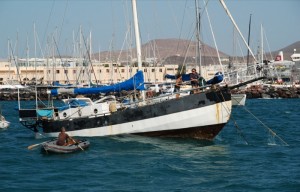
Believe me, we Mollymawks hate paying for anything, but in this instance we feel that we are making an investment. Yachtsmen need the conveniences afforded by this city. And we don’t want to find, on our return, in a few years time, that in order to take on water and make use of the shops and museums we have to fork out for a berth in the marina.This having been said, there comes a time when right-behaviour becomes idiocy. And that time comes, in Las Palmas, when the ARC goes through. During this period the marina staff are too busy to visit the anchorage and pester people for their 5 Euros per day, and so throughout this entire time no mooring fees are collected. A month goes by – and three hundered boats come and go without paying a bean – and then, when everything has calmed down again, the little man is back, knocking on the side of our boat and asking for the entire sum, including the period when no one else paid!
At this point we stormed into the office and told the management what we thought of the situation. They shrugged their shoulders and said that it was just too bad; but they never pestered us again.
Rumour has it that on January 1st 2011 the authorities in Las Palmas introduced a new Light Duties fee, payable by all vessels according to their deck area.
If anyone has any information about this we would be glad to hear about it.
Máspalomas et alia

This area offers the first available anchorage to sailors heading down the coast from Las Palmas. The dune system for which the area is locally famous forms a bulge on the extreme southern limit of Gran Canaria. Depending on the direction of the wind and the sea state one can anchor either to the east of the dunes, off Playa del Inglés, or some way to the west, off Playa Meloneras, or off the marina known as Pasito Blanco.
Although the swells were not particularly big during the time of our visit the beaches on either side of the point were swept by biggish rollers and landing in a dinghy would have been impossible – or at any rate, exceedingly wet and somewhat dangerous. Having been unable to land at either Playa del Inglés or Playa Meloneras, we re-anchored off Pasito Blanco and went ashore in the marina.
Most yachtsmen would consider this shore to be of no interest whatsoever. Having once been devoted to the growing of tomatoes, it is now an ugly brown landscape fringed with extraordinarily hideous holiday developments. One of the hotels is done up to look like a Spanish church; indeed, we were almost convinced of its authenticity – until night came and it was lit by red and purple lights. Roxanne called it The Polly Pocket.
Before the Spanish conquest of the archipelago Máspalomas was home to a thriving community of indigenous “Canarios”. More widely known as cave dwellers, these people also sometimes built stone houses. Those which they built in this vicinity have all been swept aside – all but one. At the extreme southern end of the island, at Punta Mujeres (just west of the lighthouse), there stands the last vestige of this stone-age village. It was this which brought us to visit the area, but, to tell the truth – and speaking as one who is passionate about archaeology – it is not worth a visit.
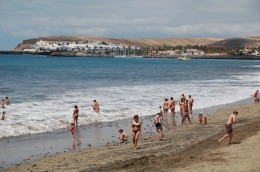
The marina of Pasito Blanco is open to all-comers. A berth for our 50 footer would have cost 27 € per night. As the manager pointed out, however, we were quite safe where we were – so why bother? He had no objection to our coming ashore into the marina with our dinghy.
Note that the anchorage would not be safe in a strong southerly – but then, we are not at all sure that the port would be either. Even as it was, the moderate swells were crashing onto the perimeter wall and covering the southern side of the marina in spray. Bigger waves would probably come straight over (just as they do at Los Gigantes and at various other south coast marinas in the Canary Islands.)
Arguineguín etcetera
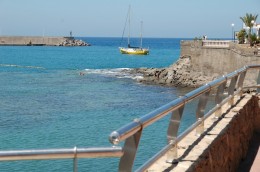
Continuing westward from the region of Máspalomas we come to Arguineguín; or, to be more exact, we come first to the bay known to visiting yotties as Cement Factory Bay, and then to the little port of Arguineguín.
Arguineguín is an uninspiring little hole. Most of the buildings look as if they were thrown up, piecemeal; the rest look as if they were thrown up in an afternoon, from whatever came to hand. On the eastern side of town a monumentally ugly residential development (initially mistaken by Yours Truly for a prison) overlooks the smelliest, dirtiest, least attractive caravan park that I have ever seen (initially mistaken for a breakers yard).
All this having been said, the little port is actually quite nice. Small ferries and fishing boats come and go, turtles saunter past, and the sun shines down; the smell from the town doesn’t reach your nostrils here, and the view to seaward is… well, it’s blue. As for the view to the west, along the coast… the least said about that the better.
There is space for half a dozen yachts to hook in behind the wall and so escape from the swells. A German friend who spent the whole winter here reckons that the place is safe even in a southerly, but that it is not so good in a south-wester. When the swells roll in from that quarter the time has come to nip back round the corner into Cement Factory Bay.
Cement Factory Bay
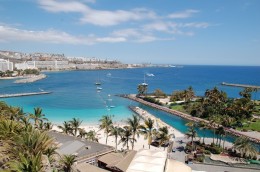
This place is more properly known as Bahía de Santa Agueda. Agueda was the patron saint of Mallorca – or so ’tis said – and when some Mallorcan traders set up camp in this very place, a good century before the Spanish conquest of the islands, they established a chapel in a cave in the cliffs and dedicated it to the holy martyr. The cave was the first Christian church in the archipelago, and it is still used as a place of worship. Since it is not signposted nor even labelled finding it is no easy task. If you want to make a pilgrimage, look for an ultra-modern triangular shaped canopy – oddly out of context in this environment – which is perched half way up a cliff. Prepare to be very disappointed, because the cave is no romantic grotto; it has been cut to the shape of a conventional room, and plastered and painted. Moreover, it is kept locked; we gained our view by peering through the keyhole.
The peninsula which lends shelter to this bay is known as Punta del Parchel, and the area behind it is called El Pajar. At one time it was home to somewhere in the region of 400 Canario families, who lived in stone houses of the sort which also stood at Máspalomas (and at numerous other places on the island) and buried their dead in a variety of tombs and graves.
Although it had long since been abandoned, this stone-age settlement was still in existence in the early years of the 20th century. Since then, time and modern developments have run amok over the entire area. The necropolis, with its mummified chiefs and pauper skeletons, was destroyed by the construction of the cement factory, and the houses were gradually robbed of stone and buried beneath a shanty town of concrete huts.
Only one last house remains, and its condition is worse even than that of the house at Máspalomas. Standing on its foundations and surveying the sprawl of badly built shacks on the hillside below, we could not help but feel that, here at any rate, man has not moved forward. Photos and reconstructive drawings of typical Canario houses clearly show that they were more attractive to look at and very much better built than the trash which has been spewed up in their place.
If you plan to anchor in this bay, note that there is a blinder (a rock awash) lying about 50 yards offshore at the eastern end of the beach.
Puerto Mogán
Once a tiny fishing port, this place is now a German-dominated tourist resort, but because the development has been carefully crafted to benefit both the visitor and the locals it does have a certain charm. The marina lies at the heart of the accommodation, amongst a warren of prettily painted houses – through half-closed eyes one can easily overlook the fact that they are some sort of time-share resort – and the port is also home to a greatly expanded fishing fleet. (Or, at any rate, the boats have expanded. In times past the fishermen owned only open dinghies, which they launched from the beach.)
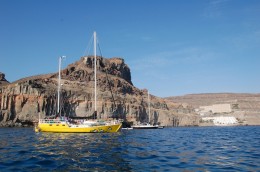
If you do not want to afford the marina, anchor just outside, beneath the cliffs. The principal attraction here is the sunshine. The main drawback is the constant flow of ferries and the perpetual whine of jet skis.
This place is not safe in a southerly gale, and boats have been known to come ashore in sudden southerly squalls, but these are principally winter phenomena and this anchorage is generally perfectly safe.
IF YOU VISIT GRAN CANARIA AND YOU FIND ANY OF THIS INFORMATION TO BE OUT OF DATE, OR OTHERWISE INCORRECT, PLEASE LET US KNOW.

